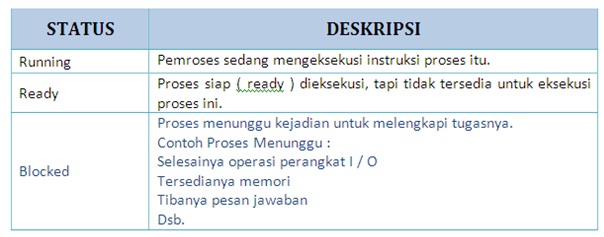There are three basic state in the process, ie running, ready, and blocked.
Description: 1. The process in the block to serve as input the requested resource is not available / requested service I / O so that the wait event appears.
2. Scheduling take another process.
3. Scheduling take this process (new).
4. Input has been available.
2.2.2 Transition Status (State) There is a transition between state-state during the life cycle process, namely:
* The newly created will soon have the Ready state.
* The state denagan running → blocked because the requested resource is not available or to request service device input / output so that the wait event appears. The process of waiting for events or the completion of the resource allocation service device input / output (event wait).
* The state denagan running → ready as the scheduler decides the execution of another process because the allotted time for that process has run out (time-out).
* The state denagan blocked → ready when resources are requested / required are available or service the device input / output is completed (event occurs).
* The state denagan ready → running because the scheduler decides the use of processors for the process because the process that was running to change state (be ready or blocked) or you have completed so removed from the system process to get a ration processing.
2.2.3 Suspend and Resume Delays (suspendsion) is an important operation and has been applied in various ways. The delay is usually brief. The process is suspended (suspended process) does not continue (resume). For the time peanjang term, resource-free process resources (stripped). The decision frees resources resource-dependent nature of each resource. Main memory should be released immediately so that delayed the process of memory that can be utilized for other processes. Resuming command of the process is the command to run the process from the point (instruction), where the process was delayed. Suspend and resume operations is important, because:
1. If the system functions poorly and may fail then the processes are suspended for diresume after the problem resolved.
* Example:
* On the printing process, when all of a sudden Kerta out the process in the delay (suspend). After the paper is inserted again, the process can proceed back on (resume).
2. Users who doubt / worry about the outcome of a process to mensuspend process (rather than directly discard (abort) process). When the user believes the process will function correctly then able to resume (resume in the instructions when in-suspend) process is suspended.
3. In response to short-term fluctuations in system load, several processes can suspend and resume when the load is returned to normal levels.



No comments:
Post a Comment